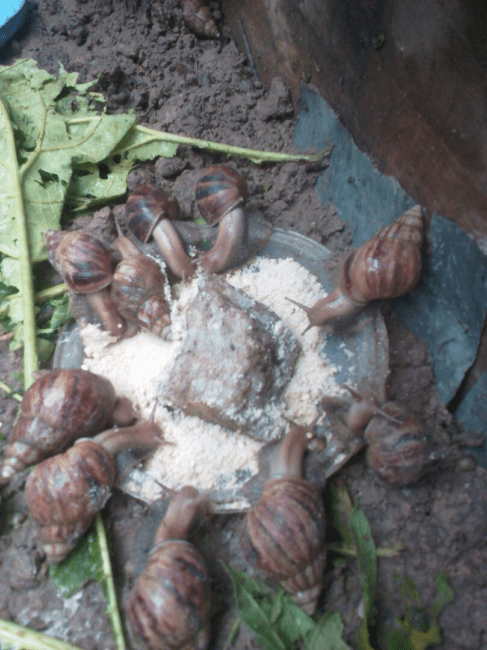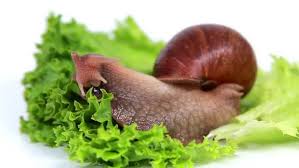Before you can start formulating feed for your snails (snail food) or start asking questions like ”what do snails eat?”, it is required that you must understand and be able to recognize and identify those materials when you see them, which is why today, we are going to be discussing about what the essential raw materials for snail food formulation is made up of.
Snails are also cold-blooded animal and therefore their feeding activities are bound to be influenced by their environment, time and season. In preparing food for snails (snail food or snail feeding), the temperature inside the pen is hugely important, ensure that the snails are comfortable.
The moisture content of the soils inside the pen (snail house) is okay, you can irrigate the pen (apply water to help moderate the temperature of the pen). The temperature should not be more than 25cm while the humidity should be around 75cm.
An average snail is comprised of 80% water, 15% protein and 2.4% fat. They contain essential fatty acids, calcium, iron, selenium, magnesium and are a rich source of vitamins E, A, K and B12. However, despite these benefits I could not eat one!
Materials needed for Snail Food (Snail Feed) Formulation

Wheat offals: Its the waste product of wheat during processing, it contains the chaff and glutenous part of wheat seed.
Bone meal: is normal cattle bone or other bone like (goat, pig, etc.).
Fish Meal: Your fish bones and other part of the fish.
Pro Vitamins and Mineral: You get that from those who sell animal feed as a premix.
Groundnut Cake: Your common kuli kuli.
SoyaBean Meal: is your main soy bean (Dried and grinded), SBM as popularly abbreviated is the whole bean ground but soya bean cake is obtained after the extraction of oil or milk from the beans.
Palm Kernel Cake (PKC): It’s the remains of Palm kernel after the oil has been extracted you can get it in the market.
Maize: Is your normal maize (dry) grind.
Oyster shell: Is shell of oyster dry and grind.
Read Also: Recommended Formula for a Self-Mix Snail Feed
Meanwhile before you start feeling that is a total waste of time to go through all these processes and the stress involve just to make your own snail food when you can easily purchase already made and bagged snail feeds from the market, i want you to understand that there are certain benefits or will I rather say certain advantages that comes with you formulating your own snail food for your snails as seen below:
Benefits of Using Formulated Feed (Advantages)
- It improves performance of the snail.
- It can be used to meet the specific requirement of the animal.
- It can be easily measured.
- It saves time and energy.
- It is good for commercial production of snail.
- It can be stored for longer period.
According to findings, Snails need a diet rich in protein for growth. Moringa is known for its medicinal properties and for its richness in protein. Fresh moringa leaves contain as much protein as an egg; dry moringa leaves contain four times more.
This means that you can also feed your snails with leaves like moringa leaves and others but that doesn’t mean that formulating a balanced ration for your snails is not required for their optimum performance and growth.
The right Snail feed is an essential practice of snail farming that needs the highest priority, as its one of the major factors that influence:
- The Flesh Size of Your Snails
- How your snails lay eggs
- Shell formation on your snails
- The Taste of Your Snails Meat (the sweeter and healthier their feed is, the better they taste)
- The Survival Rate of Your Snails
Read Also: Different Classes of Snail Feed Based on their Nutritional Requirements
In formulating this mystery snail food or snail feeds, you must understand the nutrient content of the ingredient to be used so as to combine the ingredient in the right proportion to achieve the desired result.
For example, if we want to formulate a 27% carbohydrate-containing food for snails using cocoyam, cassava, sweet potatoes and plantain as ingredients.
You have to note the weight per percentage of carbohydrate contained in each of cocoyam, cassava, sweet potatoes and plantain.
| SN | Ingredient used in (kg) | Percentage of carbohydrate |
| 1. | 20kg of cocoyam | 10% carbohydrate |
| 2. | 5kg of cassava | 8% carbohydrate |
| 3. | 15kg of plantain | 10% carbohydrate |
| 4. | 10kg of sweet potatoes | 2% carbohydrate |
| Total | 30% carbohydrate |
From the above ingredient, 20kg of cocoyam gave us 10% carbohydrate, 5kg of cassava gave 8% carbohydrate, 15kg of plantain gave 10% carbohydrate and 10kg of sweet potatoes gave 2% of carbohydrate.
Let’s assume that we want to formulate snail food that has the following percentage of carbohydrate in each ingredient.
| 5% carbohydrate in Cocoyam |
| 10% carbohydrate in Cassava |
| 8% carbohydrate in Plantain |
| 4% carbohydrate in Sweet potatoes |
| TOTAL = 27% carbohydrate in all the ingredient which is our desired carbohydrate content of the feed. |
Then if 20kg of cocoyam gives us 10% of carbohydrate what kg of cocoyam do we need to get 5% of carbohydrate?
20kg=10%
Xkg =5%
We will have xkg*10%=20kg*5%
To get this clear, let’s do without the signs
You have 10x=100
X =100/10
X=10kg
That is to say, to get 5% of carbohydrate in cocoyam, we need to measure out 10kg of cocoyam.
Do this for the rest, you will have the following results.
| SN | Ingredient used in (kg) | Percentage of carbohydrate |
| 1. | 10kg of cocoyam | 5% carbohydrate |
| 2. | 6.25kg of cassava | 10% carbohydrate |
| 3. | 10kg of plantain | 8% carbohydrate |
| 4. | 20kg of sweet potatoes | 4% carbohydrate |
| Total | 27% carbohydrate |
Now we can measure out the desired kgs so as to get our desired percentage of carbohydrate in each ingredient.
Note that this is only applicable if the weight of ingredient is known and the percentage of the desired nutrient per weight of ingredient known as well.
Precaution to be taken during snail feed formulation
To get the desired result from formulating food for snails, the following condition must be met.
- Measure all ingredients to be used
- Understand the snail’s needs before formulating a feed to solve such need.
- Grind the ingredients to powered form before formulation.
- Ensure you take correct measurement.
- Write down each measured parameters with the name.
Just like in every other animal, feeding in snail is a daily practice, most times happen more than once in a day or even once in two days depending on the farmer’s management plan.
Read Also: Effect of Tropical Climate on Animal Parasites, Vectors and Diseases


Good evening madam, i appreciate on your farm production and God blessed you in abundant. My questionis on snail food formulation. Above listed formulation,
1,Is it necessary you must get all ingredients on the production.
2, while feeding them will i add water to it?
3, when grinded, it will be in powdered form and the snail is in an open place and this is raining season, how do i manage them? I will like to get your WhatsApp phone number thanks so much.